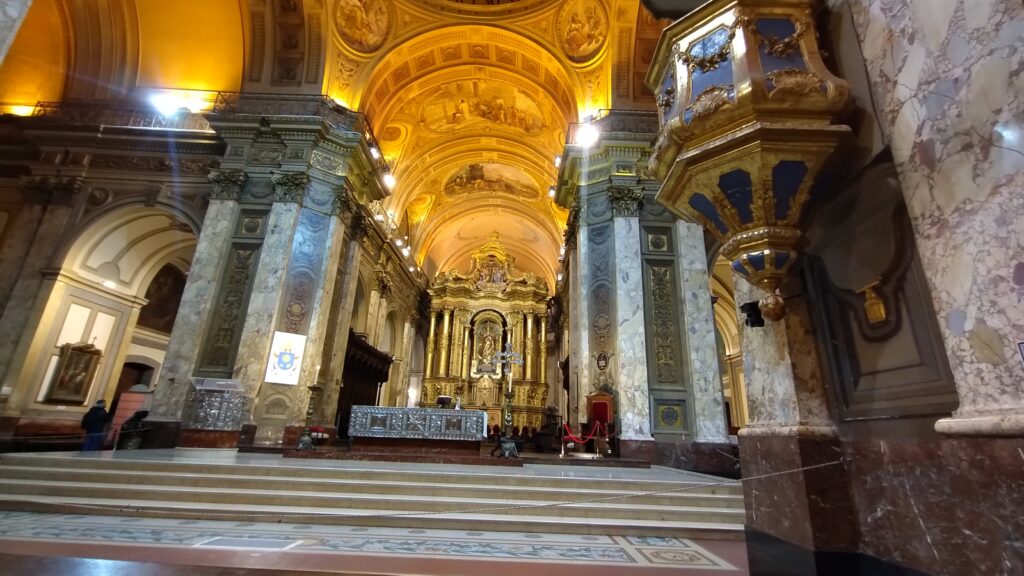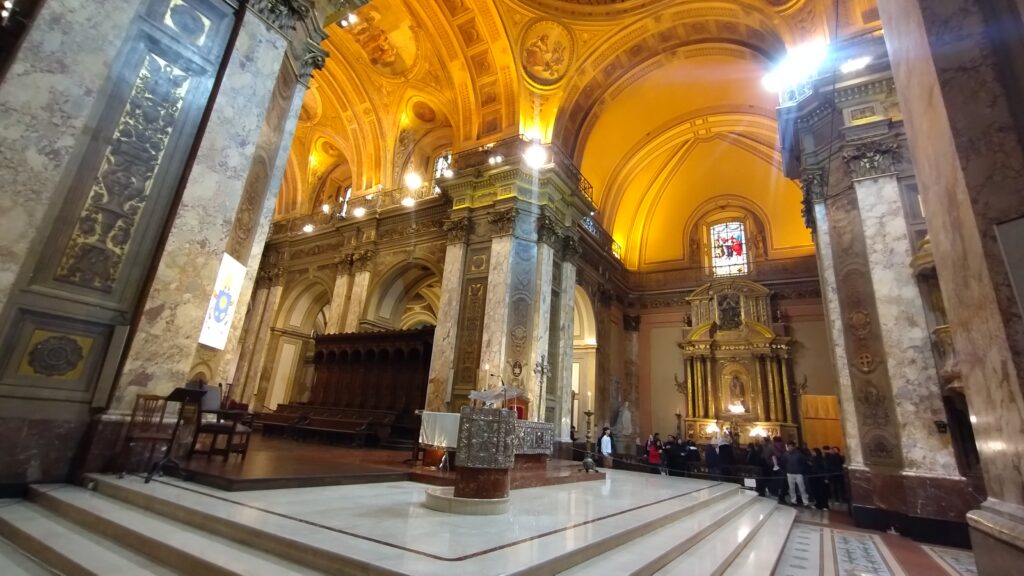The Metropolitan Cathedral of Buenos Aires is the main Catholic temple in Argentina. Also known as the Cathedral of the Holy Trinity, it is the main seat of the Catholic Church in the country and one of the most iconic buildings in the history of Buenos Aires.
Thousands of tourists, both Argentines and Catholics, flock to the Metropolitan Cathedral of Buenos Aires every day. In addition, its location in front of Plaza de Mayo and in the historic center of Buenos Aires makes it very important as a tourist attraction.
What can you see or find there? What is the origin of the Cathedral? You will see all that and much more here. Then, it will be up to you to visit the Cathedral during your stay in Buenos Aires.
Buenos Aires Metropolitan Cathedral: Everything You Need to Know Before Your Visit
What is the Metropolitan Cathedral of Buenos Aires?
The Buenos Aires Metropolitan Cathedral is the main seat of the Catholic Church in Argentina. Its five-century history began with Juan de Garay’s proposal to build a cathedral in the 16th century, marked by constant setbacks due to architectural issues and poor-quality materials and designs. As a result, the current building is the sixth and final construction after several attempts were thwarted by floods, fires, and structural defects.
The current structure was initiated in 1752 under the direction of Italian architect Antonio Masella and completed in 1852, though its final decoration wasn’t finished until 1911.
In 1822, the facade was designed with 12 columns symbolizing the twelve apostles of Jesus. In 1877, architect Enrique Alberg renovated a side nave to construct the mausoleum of General José de San Martín.
The Cathedral houses the fourteen paintings of the Via Crucis by Italian artist Francesco Domenighini and a grand, gilded altar located in the center of the main nave.
In 1942, the Buenos Aires Metropolitan Cathedral was declared a National Historic Monument and is considered one of the most important architectural works from the Colonial era.
The Tribute to Pope Francis (Jorge Bergoglio)
From 1998 to 2013, Jorge Bergoglio served as Archbishop of Buenos Aires, leading the Archdiocese. On March 19, 2013, the world was surprised when he was appointed Pope by the Vatican.
Pope Francis is honored with a dedicated museum in the Cathedral, featuring personal and liturgical items used during his 15 years of pastoral ministry in the city.
Architectural Style
One of the most striking aspects of the Cathedral is the diversity of styles visible inside. The construction of the current building began in the 18th century and was only completed in the early 20th century, passing through the hands of various architects and builders who added or changed elements ranging from baroque to fundamentally Romanesque styles. The church’s grandeur is impressive: the central nave is nearly 100 meters long, and the beautifully detailed mosaic floor covers an area of approximately 3,000 square meters.
The main facade, in neoclassical style, is inspired by the front of the Palais Bourbon in Paris. It was designed in 1822 by French architects Prosper Catelin and Pierre Benoit. The facade features twelve columns symbolizing the Apostles, resembling grand Greek structures more than typical Catholic churches.
Interior
From the right lateral nave, you can access the mausoleum that houses the remains of General José de San Martín, located in the fourth alcove. This mausoleum, created by French sculptor Carrier Belleuse and inspired by the French eclecticism of the time, has been there since 1880.
The interior dome, presbytery, transept arms, and central nave were once decorated with Renaissance-style frescoes by Italian Francesco Paolo Parisi, although these were lost due to humidity.
In the San Martín de Tours chapel (located on the left wing) is the monument to Archbishop León Federico Aneiros, crafted by sculptor Victor de Pol. This mausoleum, made from Carrara marble and stone, features the figure of the prelate kneeling at its center. The fourteen paintings of the Via Crucis, originally from the Church of Pilar, are the work of Francesco Domenighini, another Italian artist.
The grand gilded altar stands prominently in the center, with its sinuous forms and ornate decorations of flowers and stone reflecting the Churrigueresque style.
On the left arm of the church is an altar with a statue called “Santo Cristo de Buenos Aires,” a polychrome carob wood sculpture representing Christ crucified before his death, life-sized. At the end of the left nave is an altar dedicated to the Virgen de los Dolores (one of the first brought to the country).
Visiting the Cathedral
The church is open Monday to Friday from 8 a.m. to 7 p.m., and on Saturdays and Sundays from 9 a.m. to 7:30 p.m. Guided tours and audio guides in various languages are available.
Masses
Masses are held Monday to Friday at 8:30 a.m., 12:30 p.m., and 5:30 p.m., on Saturdays at 11:30 a.m., and on Sundays at 10 a.m., 11:30 a.m., and 5:30 p.m.

Where is the Metropolitan Cathedral of Buenos Aires?
The Buenos Aires Metropolitan Cathedral is located in the San Nicolás neighborhood, specifically at the intersection of San Martín Street and Rivadavia Avenue.
Directly in front of the Cathedral is Plaza de Mayo, the most symbolically, politically, and historically significant square in Buenos Aires and Argentina.
The surrounding area is filled with historical sites, places of interest, and museums, fitting for the birthplace of Buenos Aires.
Nearby is the Buenos Aires Cabildo, a key site during the events of the May Revolution in 1810. Also within walking distance are the Bank of the Argentine Nation, the Casa Rosada (presidential office), the Ministry of Economy, the Bicentennial Museum, and other important sites like Puerto Madero, the Manzana de las Luces, and Café Tortoni.
The streets surrounding the Metropolitan Cathedral and Plaza de Mayo are part of the historic core of Buenos Aires, largely preserved in their original state with cobblestone streets, old buildings, and limited vehicle traffic.
To the north of the Cathedral lies Corrientes Avenue, Córdoba Avenue, and the Retiro neighborhood. Heading east, you’ll reach Puerto Madero, while to the south is the San Telmo neighborhood.
This area is a key tourist destination and an ideal stop on a tour that includes San Telmo and Puerto Madero.
How to Get to the Metropolitan Cathedral of Buenos Aires?
Given its significance, reaching the Buenos Aires Metropolitan Cathedral doesn’t require much planning.
First, note that vehicle traffic in the area is restricted on certain days and hours, especially during the week. Therefore, it’s best to use public transportation to get to the Cathedral.
What are the best public transport options to reach the Buenos Aires Metropolitan Cathedral?
The subway is highly recommended for several reasons. Plaza de Mayo is the starting point for the D and A lines, which travel to the Belgrano area (north of the city) and the Flores neighborhood, respectively. Additionally, the E subway line has a station at Plaza de Mayo, while the C and B lines also pass close to the Cathedral. Therefore, there are multiple subway options to choose from.
Buses? Several bus lines can also bring you to the Buenos Aires Metropolitan Cathedral. Keep in mind that Leandro N. Alem and 9 de Julio avenues also have Metrobus stations, where buses travel in exclusive lanes.
Some bus lines that can take you to Plaza de Mayo include: 2, 7, 8, 9, 28, 29, 33, 50, 56, 59, 64, 67, 86, 91, 103, 126, 140, 146, and 180.

Why Visit the Metropolitan Cathedral of Buenos Aires?
The Most Important Site for the Catholic Community
The Buenos Aires Metropolitan Cathedral is the most important site for the Catholic community in Buenos Aires, which is the predominant religion.
Thousands of tourists and Argentinians visit the Cathedral, whether for tourism, historical interest, or religious purposes. It also hosts important celebrations involving the country’s most significant institutional authorities.
The History of Buenos Aires in One Building
The Metropolitan Cathedral is one of the best testimonies of Buenos Aires’ history. Remember, it underwent several constructions and faced issues not only related to building and design but also to financing conditions.
Despite these challenges, the Cathedral has stood in the same location since its origins in the 16th century.
Thus, visiting the Metropolitan Cathedral, along with Plaza de Mayo, Casa Rosada, and the Buenos Aires Cabildo, provides a “face-to-face” encounter with the city’s genuine history.
Mausoleum of General José de San Martín
The remains of General José de San Martín, a key figure in Argentina’s independence and that of other Latin American countries like Peru, rest in the Metropolitan Cathedral.
San Martín is considered the father of the Argentine nation, and as such, he is honored daily in the Metropolitan Cathedral. His mausoleum is guarded by units of the Regiment of Grenadiers, the military unit San Martín founded for the struggles for independence and national liberation.
When you visit the mausoleum, you will always see two Grenadier guards watching over San Martín’s remains. This strong symbolic presence reflects the importance of his figure to the Argentine nation.
A Marvelous Architecture
Whether or not you have an interest in religion, the architecture of the Buenos Aires Metropolitan Cathedral will leave you in awe.
Take the time to explore the Cathedral thoroughly, appreciating the columns, floors, ceilings, artwork, and spatial organization.
The Cathedral’s architecture is striking for the diversity of styles visible inside. This is no coincidence, nor the work of a single architect, but rather the result of a building project that began in the 18th century and was only completed in the early 20th century. Over that time, the project passed through the hands of different architects and builders who added or altered elements, from Baroque to Romanesque.
But what truly impresses about the Cathedral is its scale and proportions: the central nave is nearly 100 meters long, and the mosaic floor covers approximately 3,000 square meters.


